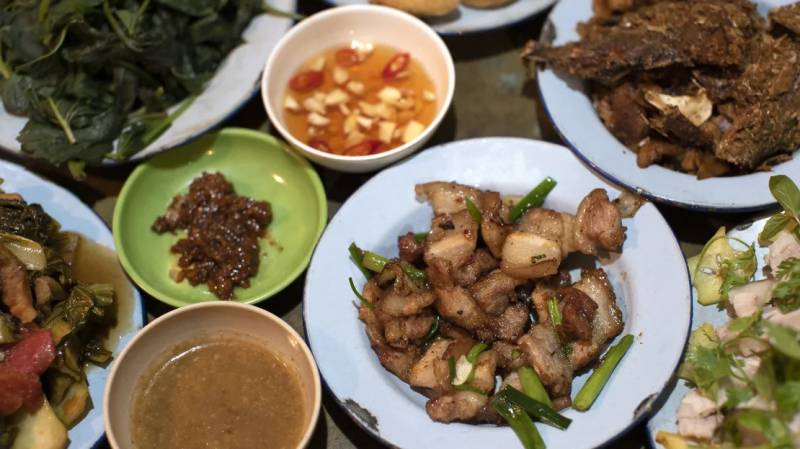37 Nam Trang, a Hanoi restaurant, revives Vietnam's post-war subsidy era with nostalgic decor and traditional dishes, offering a unique dining experience steeped in history.

At first glance, 37 Nam Trang might seem more like a museum or art gallery than a restaurant. Located in a village just 15 minutes from Hanoi's bustling Old Quarter, the eatery—officially named State-Run Food Shop #37—offers a unique dining experience that transports guests back to Vietnam’s post-war era, from 1976-1986, a time when the state controlled the economy and food was rationed. The restaurant’s atmosphere, decor, and menu are designed to evoke memories of that period, providing a nostalgic journey for those who lived through it and an educational experience for younger generations and curious foreigners.
A Journey Through TimeThe restaurant's decor is rich with historical artifacts from Vietnam's subsidy era, which followed the end of the war. On the walls, you’ll find old photographs, military caps, and green lanterns, while an oversized, chipped blue scale greets visitors at the entrance, piled high with root vegetables. These items are more than just decorations—they are symbols of a difficult yet resilient time in the country’s history.
The space also includes relics like old radios, television sets, and even a display case filled with ration stamps, which were once used to purchase food during the period when Vietnam's economy was centrally controlled. These artifacts remind diners of the challenges of that era and add a layer of historical context to the dining experience.
Reviving the Subsidy PeriodDang Thanh Thuy, the 47-year-old owner of 37 Nam Trang, was a child during the post-war period, and though her memories of that time are not vivid, she feels a deep connection to it. Her restaurant serves as both a tribute to Vietnam’s history and a way to keep the memory of those tough times alive.
“Coming to our place, the guests reminisce and get back the memories of the old days,” says Thuy. "I want everyone to join me in preserving and promoting a certain part of our country’s history."
While Thuy herself didn’t fully live through the struggles of the subsidy period, she credits the stories passed down from older generations for inspiring her to recreate the period’s culinary and cultural essence. For Thuy, every object and dish holds personal significance, from the old blue scale used to weigh food rations to the rustic, resourceful meals that defined everyday life during those years.
A Taste of NostalgiaAt 37 Nam Trang, the menu reflects the culinary traditions of the subsidy era, when people made do with limited resources and found inventive ways to stretch ingredients. The dishes harken back to the food of Thuy’s childhood, offering simple yet flavorful meals that tell the story of Vietnam’s resilience.
The restaurant’s cuisine is based on freshly cooked seasonal ingredients, with a focus on seafood like shrimp, river crabs, snails, eels, and frogs. One popular dish is pork cooked in shrimp paste, which is served alongside shrimp paste dipping sauces—both staples of Vietnamese cuisine, known for their pungent, salty, and funky flavors.
Thuy also brings back memories of how people once stretched ingredients to their fullest. For example, during the subsidy period, pork lard was often used as both cooking fat and garnish. Today, diners can enjoy dishes where pork is not merely a supporting ingredient but the star, such as in the pork adobo. This dish is rich and savory, best enjoyed with a dip in fish sauce and paired with fresh herbs and tart slices of starfruit, balancing the fatty richness with crisp, refreshing flavors.
For Locals and Foreigners AlikeSince its opening in 2012, 37 Nam Trang has drawn in both locals and foreigners alike. For older Vietnamese visitors, the restaurant offers a deeply emotional experience, reconnecting them with memories of a challenging but defining time in their lives. For younger generations, the restaurant serves as an educational space, where they can learn about how their parents and grandparents lived, cooked, and survived during the post-war period.
Foreign visitors are also attracted to the restaurant, particularly for dinner. The menu, with its visual aids, makes it easy for non-Vietnamese speakers to navigate the unfamiliar yet tantalizing dishes. Foreigners are often drawn to the authenticity of the experience, eager to learn about the country's history through its food and cultural symbols.
A Simple Drink, A Rich ExperienceFor drinks, Thuy keeps it simple, serving only local beers—Truc Bach, Hanoi, and Saigon—the same brands that were available during the subsidy period. The unsweetened iced tea, a staple of Vietnamese dining, is another nod to the simplicity of the times.
Thuy’s commitment to preserving this slice of Vietnam’s past extends beyond the food. She hopes that her restaurant will inspire a broader appreciation for Vietnam’s history, encouraging others to keep the memories of the subsidy period alive. “I want everyone to join me in preserving and promoting a certain part of our country’s history,” Thuy says, believing that by remembering the past, the Vietnamese people can appreciate the progress they have made and continue to build on it.





















